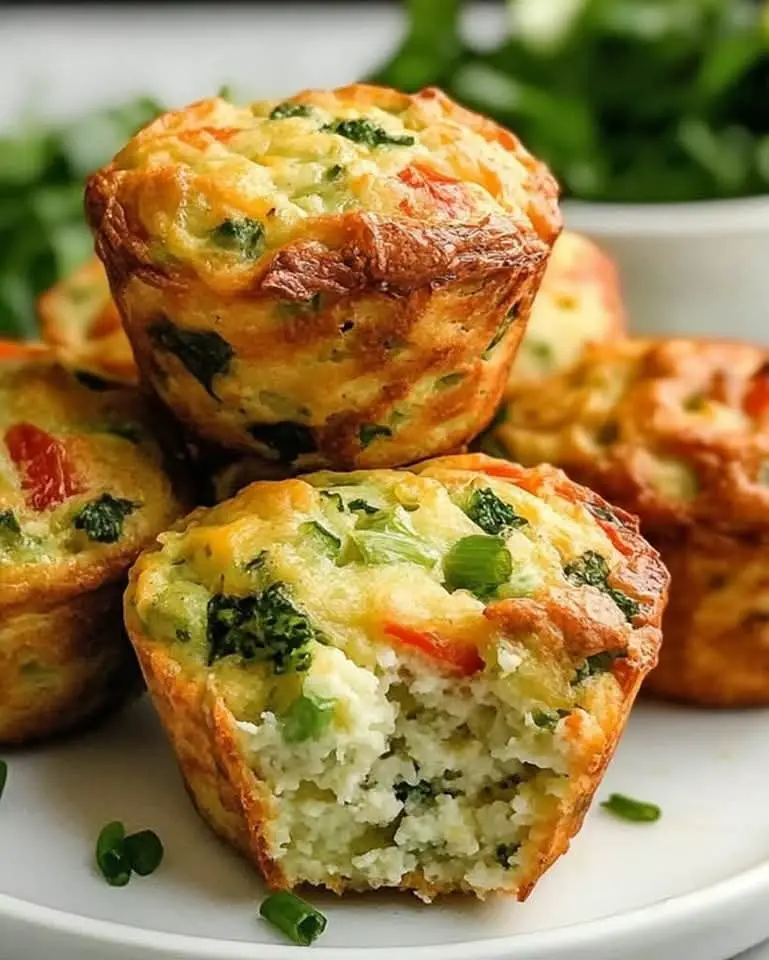Savory Cottage Cheese Breakfast Muffins: An Easy & Healthy Morning Delight
Start your day with the delightful aroma of freshly baked Savory Cottage Cheese Breakfast Muffins. These easy and healthy muffins are perfect for those busy mornings when you need a quick and nutritious meal. Packed with protein from cottage cheese and the savory goodness of fresh herbs, these muffins are both satisfying and flavorful. They’re also incredibly versatile, making them the perfect addition to any breakfast spread or brunch gathering.
The beauty of these muffins lies in their simplicity. With minimal prep time and basic ingredients, you can whip up a batch in no time. The combination of cottage cheese ensures a moist texture, while the herbs and optional cheese provide a burst of flavor in every bite. Not only are they delicious, but they’re also a healthier alternative to typical sugary breakfast pastries, allowing you to indulge guilt-free.
Quick Recipe Highlights
- Flavor Profile: These muffins offer a savory flavor with hints of onion and garlic, complemented by the creaminess of cottage cheese.
- Texture: Expect a moist and tender crumb, with occasional bursts of melted cheese goodness.
- Aroma: The fresh scent of baking bread fills the kitchen, enhanced by aromatic herbs.
- Visual Appeal: Golden muffins with specks of green herbs and melted cheese make for a tempting display.
- Skill Level Needed: Perfect for kitchen novices, requiring only a mixing bowl and a muffin tin.
- Special Equipment: A non-stick muffin tray and mixing bowl are the only essentials needed.
Recipe Overview
- Difficulty Level: This recipe is genuinely easy, requiring basic stirring and no advanced baking skills. Even beginners will feel like a professional baker.
- Category: Ideal for breakfast and brunch, but also suitable as a snack or light lunch option.
- Cuisine: While these muffins have a universal appeal, they draw inspiration from European baking traditions.
- Cost: With budget-friendly ingredients like cottage cheese and herbs, this recipe is economical and accessible.
- Season: Perfect year-round, but particularly delightful in spring and summer when fresh herbs are abundant.
- Occasion: Excellent for casual breakfasts, weekend brunches, and as a quick snack to-go.
Why You’ll Love This Recipe
Whether you’re serving them fresh out of the oven or as a make-ahead option, Savory Cottage Cheese Breakfast Muffins are a versatile addition to your meal plan. The blend of simple, wholesome ingredients means they deliver on both flavor and nutrition. Rich in protein and low in sugar, they’re a fantastic choice for health-conscious eaters. Their savory profile makes them a delightful alternative to sweet muffins, ensuring variety in your breakfast routine.
Busy schedules often demand quick solutions, and these muffins deliver just that. With a brief prep and bake time, they’re perfect for morning hustle. Bake a batch on Sunday, and you’re set for the week with grab-and-go breakfast delights. Their portable nature makes them excellent for commuters or school lunches too.
Nutritional benefits are plentiful – each muffin packs a punch of protein and calcium thanks to the cottage cheese. They’re also versatile enough to adapt to various dietary needs. Whether you’re looking for low-carb options or gluten-free variations, these muffins can be easily customized.
When entertaining, these savory muffins offer a unique option that stands out among traditional breakfast offerings. Their flavor and texture make them appealing to a variety of palates, and their attractive presentation adds a charming element to any table setting.
Finally, the cost-effectiveness of these muffins ensures they won’t break the bank. With common pantry ingredients and minimal prep time, they’re an affordable option that doesn’t compromise on taste or quality. They’re also a great way to use up leftover herbs or cheeses you might have on hand.
Historical Background and Cultural Significance
The concept of savory muffins can be traced back to various culinary traditions where bread and cheese play a central role. European countries, particularly in the Mediterranean and Central Europe, have long embraced bread as a staple, pairing it with local cheeses and herbs to enhance flavor.
In the United States, the evolution of muffins from sweet to savory is relatively recent, aligning with a growing trend towards healthier breakfast choices. As people seek alternatives to sugar-laden pastries, savory muffins have gained popularity for their nutritional benefits and hearty flavor profiles.
The versatility of this recipe has led to numerous regional adaptations. In Italy, for example, variations might include sundried tomatoes and basil, while in France, the addition of ham and Gruyère cheese offers a twist on the classic.
The widespread appeal and adaptability of savory muffins have cemented their status in modern culinary culture. They bridge the gap between traditional bread and contemporary breakfast items, satisfying a variety of tastes and dietary preferences.
Ingredient Deep Dive
Cottage cheese serves as the cornerstone of these muffins, offering cultural roots in Eastern European cuisine, where it’s often used in both sweet and savory dishes. Its creamy texture and mild flavor allow it to blend seamlessly into the batter while providing a protein boost.
Nutritionally, cottage cheese is a powerhouse. Packed with essential nutrients like calcium and vitamin B12, it’s also low in fat and calories, making it a suitable option for a balanced diet. When selecting cottage cheese, opt for full-fat versions for the creamiest texture. Store it in the refrigerator and use it within a week of opening to maintain freshness.
Fresh herbs play an essential role, bringing vibrant flavors and a fragrant aroma to the muffins. Whether it’s chives, parsley, or dill, herbs are rich in antioxidants and add a burst of color. When choosing herbs, look for bright green leaves without wilting or yellowing. Keep them in the refrigerator wrapped in a damp paper towel to prolong their life.
These muffins are quite forgiving, allowing for a variety of substitutions. If you’re out of cottage cheese, ricotta can be an excellent replacement. Vegan alternatives like almond-based ricotta are suitable options for those avoiding dairy. For the herbs, dried versions can work in a pinch, though fresh will always offer superior flavor and aroma.
Common Mistakes to Avoid
- Overmixing the batter can lead to dense muffins. Stir just until combined to ensure a light, fluffy texture.
- Using low-fat cottage cheese may result in drier muffins. Stick to full-fat options for the best results.
- Not preheating the oven can cause uneven baking. Ensure your oven is at the right temperature before baking.
- Filling muffin tins too high can lead to overflow. Aim for filling each cup about two-thirds full.
- Neglecting to grease or line the muffin tin can result in sticking. Use non-stick spray or muffin liners for easy removal.
- Skipping the cooling step may lead to soggy bottoms. Allow muffins to cool slightly in the tin before transferring to a wire rack.
- Opening the oven door frequently to check can cause uneven rising. Minimize peeking during the bake.
- Using cold ingredients can affect the rise. Ensure eggs and cheese are at room temperature for best results.
- Ignoring precision in measurement can alter the muffin’s structure. Stick to the recipe measurements for consistency.
- Storing muffins while still warm can create condensation and affect texture. Cool completely before storage.
Essential Techniques
Mixing the batter just until the ingredients are combined is crucial to achieving the best texture. Overmixing can lead to gluten development, resulting in tough muffins. Master this by using a gentle hand and stopping as soon as there are no visible streaks of flour.
Properly filling the muffin tins ensures even baking and attractive muffins. Use an ice cream scoop or a spoon to divide the batter evenly. This technique helps maintain uniformity in your muffins’ rise and appearance, allowing for an elegant presentation.
Monitoring baking time closely is key to avoiding over or under-baked muffins. Set your timer and check for doneness by inserting a toothpick into the center. If it comes out clean, the muffins are ready. Visual cues, such as a golden-brown color and a springy texture to the touch, also indicate doneness.
Pro Tips for Perfect Savory Cottage Cheese Breakfast Muffins
Experiment with mixing in a variety of cheeses for additional flavor complexity. Feta, cheddar, or even a bit of Parmesan can elevate the taste profile while staying true to the savory theme.
Test the balance of herbs to suit your palate. If you love a stronger herb presence, increase the quantity slightly, and experiment with different combinations to find your perfect match.
Incorporate vegetables like finely chopped bell peppers or spinach to add nutritional diversity and a pop of color. This also boosts the health factor of the muffins.
For a golden top crust, sprinkle a bit of extra cheese on top of each muffin before baking. This not only improves visual appeal but also adds a delightful crisp texture with every bite.
Consider using silicone muffin liners to avoid sticking and ensure easy cleanup. This small investment can make a significant difference in your baking experience.
Always allow muffins to cool properly before removing them from the tray. This step is crucial to maintaining their structure and preventing crumbling.
Whip up a double batch on your baking day, as these muffins freeze beautifully. You’ll have a go-to breakfast on hand even on the busiest of mornings.
Variations and Adaptations
To infuse regional flavors, adapt the recipe with Mediterranean ingredients like olives and sun-dried tomatoes, offering a tangy twist and an appealing visual variety.
With seasonal adaptations, incorporate fresh spring onions in the spring, or try roasted bell peppers in the fall for a warming, earthy touch that enhances the muffins’ appeal.
Dietary modifications are easily achievable. Substitute flour with a gluten-free blend for those with intolerances, or use almond flour for a lower-carb option that aligns with the keto lifestyle.
For unique flavor variations, experiment by adding curry powder for a subtle heat or smoked paprika for deeper, more complex notes that turn each muffin into a distinctive culinary experience.
Texture modifications can involve adding crushed nuts or seeds to the batter, providing a delightful crunch and added nutrients, thus enhancing both dietary value and multi-sensory enjoyment.
Explore presentation alternatives by baking the batter in mini muffin tins for bite-sized hors d’oeuvres, perfect for parties or as an elegant addition to your brunch buffet.
Serving and Presentation Guide
For elegant plating, serve muffins warm on a wooden board with garnishes like fresh herbs or sliced avocados, creating an inviting and rustic look that enhances their savory character.
Garnishing ideas include a light drizzle of herb-infused olive oil or a sprinkle of sea salt and freshly cracked black pepper, elevating both the look and flavor of each serving.
Traditional accompaniments might include a side of fresh garden salad or a serving of smoked salmon, playing up the European roots and adding delicious complementary textures.
For modern serving suggestions, pair these muffins with a dollop of Greek yogurt or cottage cheese seasoned with a pinch of dill, combining creaminess and tang for a delightful side.
Temperature considerations involve serving muffins slightly warm or at room temperature, allowing the flavors to fully bloom and the aroma to captivate your dining companions.
Portion control tips suggest serving one or two muffins as a breakfast portion, ensuring a satisfying meal without overindulgence, particularly when paired with other breakfast elements.
Wine and Beverage Pairing
Pair these savory muffins with a crisp white wine, such as a Sauvignon Blanc, which complements the fresh herb flavors and adds a refreshing acidity to the meal.
For non-alcoholic alternatives, consider a cucumber-infused water or a zesty lemon tea to balance the savory and creamy notes, providing a refreshing contrast.
For coffee or tea pairings, opt for a light roast coffee or a green tea with floral undertones, harmonizing with the muffins’ delicate flavor profile while cutting through the richness.
Temperature considerations suggest serving drinks slightly chilled, which can enhance the refreshing aspect of beverages and complement the warm, savory elements of the muffins.
Explore serving suggestions such as adding fruit slices to plain water, creating a visually appealing and refreshing accompaniment with balanced hydration and a hint of sweetness.
Storage and Shelf Life
Store muffins in an airtight container at room temperature for up to 2 days to maintain their fluffy texture. For longer preservation, refrigerate them for up to a week.
Temperature requirements for refrigeration should be set at or below 40°F to prevent spoilage and ensure food safety while preserving the muffins’ freshness.
Choose airtight containers to keep moisture and external aromas at bay, allowing the muffins to retain their flavor integrity and original texture over time.
Check for signs of spoilage, such as off smells, mold, or significant drying, to ensure safety and optimal enjoyment, discarding any muffins that appear compromised.
For reheating instructions, use a preheated oven or toaster to warm muffins for about 5 minutes, restoring their freshly baked aroma and bringing out their savory flavors.
When freezing, place muffins in a single layer and wrap them individually in plastic wrap before storing them in a freezer-safe bag, which conserves the quality and makes reheating straightforward.
Make Ahead Strategies
Plan a prep timeline by measuring dry and wet ingredients in separate bowls the night before, streamlining the baking process and saving valuable morning minutes.
Store batter-filled muffin tins in the refrigerator overnight, ready to bake in the morning, ensuring a stress-free start with minimal early-morning preparation effort.
Assess the quality impact by baking a test muffin ahead of time, noting any adjustments to ingredient proportions or baking durations for your personal taste preference.
When assembling pre-baked components like chopped herbs or grated cheese, consider airtight storage to maintain their flavor potency until baking time.
For reheating guidelines, gently warm muffins either directly from the refrigerator or defrosted overnight from frozen, retaining their original texture and flavor quality.
Add fresh elements post-reheat, such as a sprinkle of fresh herbs or a dollop of creamy cheese, revitalizing their appearance and enhancing their immediate past-bake freshness.
Scaling Instructions
To halve the recipe, adjust each ingredient’s measurement proportionally, paying careful attention to maintain the core ratios, ensuring consistency and success in a smaller batch.
For doubling or tripling the recipe, ensure oven space and bake time management, using multiple trays if necessary and considering additional rotations during cooking for even baking.
Adjust equipment size as needed, such as using larger mixing bowls or multiple muffin tins, to handle increased ingredient volumes efficiently while maintaining a smooth workflow.
Alter timing modifications by incrementally increasing baking time as needed for larger batches, checking more frequently towards the end of the initial bake time to avoid overcooking.
Consider storage after scaling by planning adequate containers for both fresh and frozen muffins, ensuring longevity and maintaining quality for your expanded batch.
Nutritional Deep Dive
Break down the macronutrient profile, highlighting the protein content from cottage cheese, moderate carbohydrates from flour, and small amounts of fats for balanced energy delivery.
Detail micronutrient analysis, pointing out the calcium and phosphorus found in cheese and eggs, supporting bone health and energy metabolism as part of a balanced breakfast option.
Discuss the health benefits, such as promoting muscle maintenance through quality protein sources and supporting weight management due to the muffins’ filling nature and portionable size.
Consider dietary needs, acknowledging the muffins’ naturally low sugar content and potential for gluten-free adaptation, broadening their appeal for diverse dietary preferences and restrictions.
Analyze portion guidelines, advising a serving of one or two muffins, dependent on individual caloric requirements, allowing room for additional breakfast accompaniments as preferred.
Provide weight management tips, suggesting consumption alongside a source of fiber, like fresh fruit or greens, to complement the muffins’ protein content and enhance satiety.
Dietary Adaptations
For gluten-free adaptations, use all-purpose gluten-free flour blends that mimic the textural properties of regular flour while catering to celiac-friendly lifestyles.
To achieve a dairy-free version, substitute regular cottage cheese with plant-based versions or silken tofu for a creamy alternative, maintaining texture and taste without lactose.
Create a vegan version by replacing eggs with flax eggs (ground flaxseed mixed with water) and choosing non-dairy cottage cheese options, preserving savory elements and nutritional appeal.
Implement a low-carb twist by using almond flour or coconut flour instead of traditional flour, yielding muffins that align with ketogenic needs without sacrificing flavor or satisfaction.
For a keto-friendly approach, focus on high-fat and low-carb replacements, such as adding shredded cheese and using almond flour, creating a richer, diet-compliant savory treat.
Explore paleo modifications, opting for grain-free flour options like cassava or almond and finding complimentary ingredients like coconut oil or honey, ensuring adherence to paleo-guidelines.
Address low-FODMAP needs by using lactose-free cheese options and checking yeast extract levels in available flours, creating muffins that align with digestive comfort
Troubleshooting Guide
For texture issues, ensure proper ingredient ratios and avoid overmixing. Adjusting hydration or baking times can resolve dry or dense muffins for future batches.
Balance flavors by tasting batter before baking. Adjust spices, herbs, and salt as preferred, considering personal taste tolerances and desired muffin flavor profiles.
Correct temperature problems by confirming oven calibration. Maintain accurate preheating and monitoring to prevent undercooked or unevenly cooked results.
Address equipment challenges by using the correct muffin tin sizes and ensuring adequate non-stick preparation, minimizing sticking and ensuring uniform structure.
Adapt ingredient substitutions carefully, considering modifications’ impact on flavor, texture, and nutritional content, trialing adjustments with small batches where possible.
Tackle timing concerns by closely observing bake progress and adjusting based on initial results, implementing incremental checks towards cooking completion for fine-tuning.
Recipe Success Stories
Engage with community feedback showcasing muffin adaptations, from international variations using diverse spices to family-favorite iterations, emphasizing culinary creativity.
Celebrate variation successes through stories of ingredient swaps, such as achieving dairy-free outcomes with plant-based cheeses or creating richer profiles with added traditional cheeses.
Share adaptation anecdotes highlighting dietary control victories, where readers navigate gluten or carb restrictions without losing connection to shareable, crowd-pleasing muffins.
Highlight reader contributions, capturing unique cultural spins on the base recipe or sharing delightful, tried-and-true methods preserved in family traditions.
Offer photography strategies, where readers showcase muffin presentation through color contrasts and plate compositions, ensuring visual appeal that invites indulgence.
Frequently Asked Questions
Yes, these muffins freeze beautifully. After baking, allow them to cool completely before wrapping individually in plastic wrap. Store them in a freezer-safe bag for up to 3 months. To enjoy, simply thaw them overnight in the fridge and reheat in the oven.
What can I use instead of cottage cheese?
Ricotta cheese or even Greek yogurt can be used as substitutes. For a vegan option, consider almond-based ricotta or silken tofu to maintain the texture and some of the creaminess that cottage cheese provides.
How do I avoid dry muffins?
The key to moist muffins lies in not overbaking and in using full-fat cottage cheese. Ensuring you do not overmix the batter will also help maintain moisture during the bake.
Can I add extra vegetables?
Absolutely! Finely chopped vegetables like bell peppers, spinach, or tomatoes can be added for extra flavor and nutrients. Just ensure they are well-drained to prevent excess moisture in the batter.
What herbs work best in this recipe?
Fresh herbs such as chives, parsley, dill, or thyme work wonderfully, imparting a subtle fragrant note. Tailor the herbs to your taste preferences or what’s in season for elevated flavors.
Can I use whole wheat flour?
Yes, whole wheat flour can replace all-purpose flour. You’ll be adding a nutty layer to the taste, but may need to increase liquid slightly to maintain desired muffin moisture and structure.
Are these muffins healthy?
These muffins are a healthy option compared to traditional sweet muffins. They’re high in protein, reasonably low in fat, and provide essential nutrients like calcium, making them a balanced breakfast choice.
Do I need special equipment to make these?
No special equipment is required. A standard muffin tin and mixing bowl will suffice. For ease, you may use silicone muffin liners for non-stick baking and simple cleanup.
How should I store the muffins once baked?
After cooling, store them in an airtight container at room temperature for up to two days, or refrigerate for up to one week. For retaining freshness longer, the freezer is a good option.
What can I serve these muffins with?
Pair these savory delights with yogurt, a fresh garden salad, or alongside other brunch staples. Depending on the meal’s context, you can get creative with accompaniments and beverages.
Additional Resources
Explore related recipes that incorporate cottage cheese as a core ingredient, such as savory pancakes or baked omelets, offering delicious and nutritious breakfast alternatives.
Dive into technique guides focusing on muffin baking essentials, covering everything from ingredient combinations to understanding baking times for achieving fluffiness.
Find ingredient information exploring the diverse world of cheeses and herbs, enriching your knowledge of aromatic profiles, regional uses, and how they integrate into baking.
Review equipment recommendations for muffin baking, considering non-stick options, high-quality liners, and efficient storage solutions that elevate your home-baking practices.
Celebrate seasonal variations and ingredient swaps during different parts of the year, curating festive or holiday-themed muffin options that embrace regional traditions and seasonal bounties.
Print
Savory Cottage Cheese Breakfast Muffins
Description
These savory muffins are packed with protein and flavor, perfect for a quick and healthy breakfast.
Ingredients
For the Crust:
- 1 cup cottage cheese
- 2 eggs
- 1/2 cup all-purpose flour
- 1/2 teaspoon baking powder
- 1/4 cup chopped spinach
- 1/4 cup grated Parmesan cheese
- Salt and pepper to taste
Instructions
1. Prepare the Crust:
- Preheat the oven to 350°F (175°C) and grease a muffin tin.
- In a large bowl, mix cottage cheese, eggs, and flour until well combined.
- Add baking powder, spinach, Parmesan cheese, salt, and pepper. Stir until just mixed.
- Divide the mixture into the muffin tin and bake for 20-25 minutes until golden brown.
- Let the muffins cool in the tin for a few minutes before transferring to a wire rack.
Notes
You can customize the seasonings to taste.




